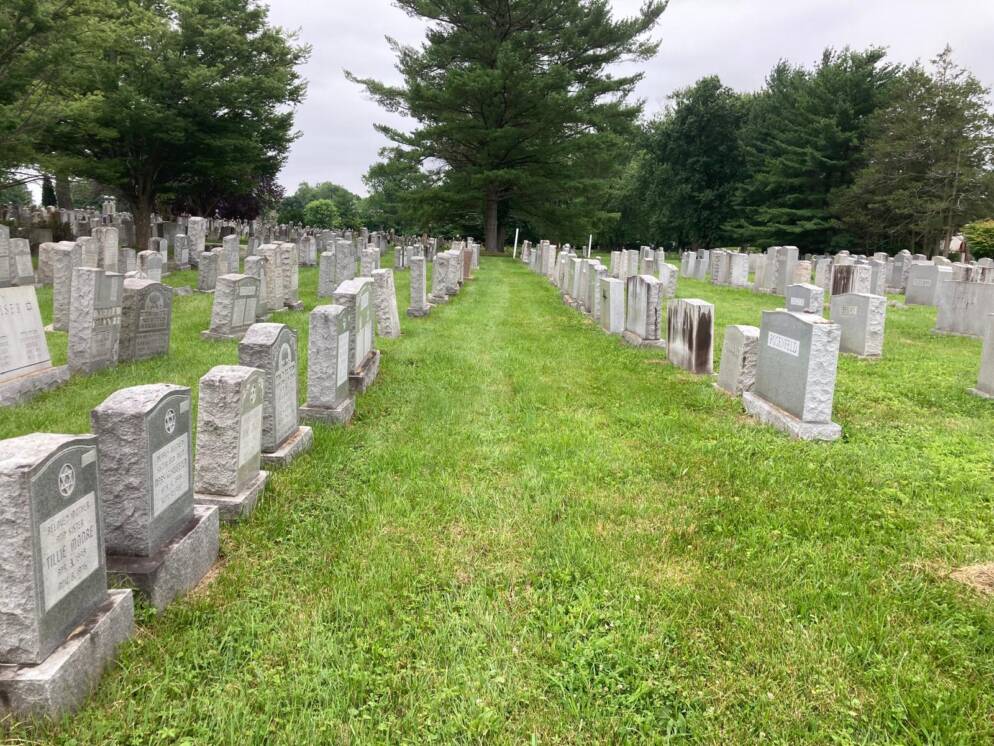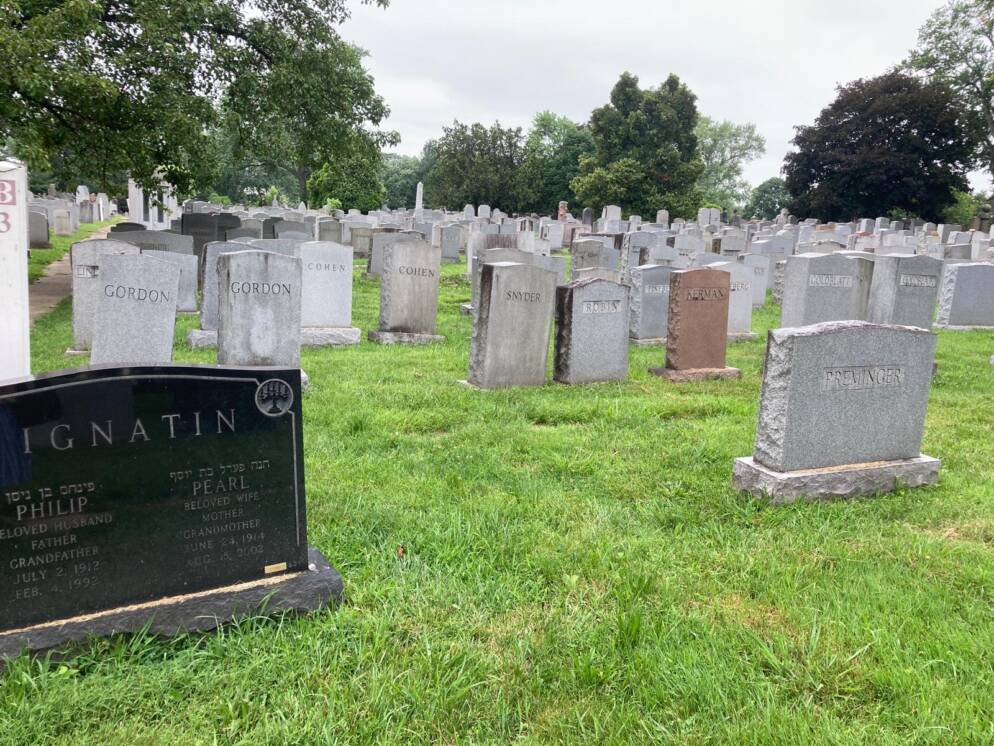 Har Jehuda Cemetery in Upper Darby. (Photo by Dinah Bucholz)
Har Jehuda Cemetery in Upper Darby. (Photo by Dinah Bucholz)
By Dinah Bucholz
When revenue from burials at Har Jehuda Cemetery declined, nature took over. Weeds, vines and trees covered headstones and choked the aisles between graves, making the paths impassable. Online reviews from 2019 to 2022 posted unflattering photos and comments like “I would not put my dog in this place” and “one of the most disgraceful cemeteries I have ever encountered” to describe the historic cemetery in Upper Darby.
Equally concerned, Marvin Abrams, a retired business owner and regular visitor, said that the grass was so tall he had trouble reaching the graves of his relatives. The octogenarian visits the local cemeteries to look after the dignity of those who’ve passed on, in a tradition he inherited from his parents.
“The cemetery was never in the condition that we found it in now,” he said.
But, in fact, the burial grounds were in worse shape during the pandemic. The cemetery had already begun to suffer from neglect a few years prior, according to general manager Larry Moskowitz, great-grandson of Julius Moskowitz, the Russian-Jewish immigrant who founded the cemetery in 1896. By 2024, despite several years’ worth of cleanups organized by a committee of volunteers called Friends of Har Jehuda, the overgrowth had reached its peak. At that point, an anonymous donor, distressed over the state of disrepair, provided funds for six months’ worth of landscaping.
This was welcome news to Shira Alberts, a nurse practitioner and driving force behind Friends of Har Jehuda. She had previously reached out to Rabbi Nathan Martin of Congregation Beth Israel in Media, which owns a community section in the cemetery, and he, in turn, contacted local synagogues to help raise funds. Alberts said that Beth Israel has provided indispensable administrative support, including hosting the Friends of Har Jehuda web page.
So when the anonymous donation appeared, it was Alberts who hired Carlos Landscaping to give the cemetery a makeover. The owner, Carlos Lemus, said that eight to 10 people worked for about 10 days to clear out the heavy vegetation, using chainsaws and weed whackers. The funds allowed the landscaper to mow the 27-acre cemetery every other week, but now that the funds have run out, Friends of Har Jehuda scramble each month to raise enough money to maintain the cemetery. With the cost of each cut at $3,500, keeping the growth in check this way remains challenging, Martin said.
Nevertheless, Alberts said that Lemus comes through when funds are low.
“I try to work with them,” Lemus said, because of the satisfaction he takes in seeing the dramatic improvement.
 Har Yehuda Cemetery. (Photos by Dinah Bucholz)
Har Yehuda Cemetery. (Photos by Dinah Bucholz)
In the meantime, Friends of Har Jehuda supplement the mowing with four cleanups a year. Linda Cohen, a retired psychologist and member of Beth Israel, got involved when she couldn’t read the inscription on her husband’s gravestone because it had been obscured by the tall grass. At the time, the congregation organized a cleanup in preparation for a funeral, and Cohen has been attending cleanups regularly since then.
Another volunteer is Eileen S. Sklaroff, president emerita of the Female Hebrew Benevolent Society, founded in 1819 to help indigent Jewish women. She also runs the Dignified Burial Fund, work that connects her to various local cemeteries. She said that when she saw the cemetery before the major overhaul, it was “a shonda.” She has been working to “create a model of nonprofit … that would be able to raise money and take over the care and maintenance of several cemeteries,” Martin said.
That’s because the struggle to raise funds every month to squeak by is unsustainable, Alberts said. When asked what she would do if money were no object, she said, “Let’s set up an endowment so we can maintain it. Let’s invest in the infrastructure so that it’s more robust. And let’s create partnerships and curriculum so that students…so that this would be a living cemetery.”
Thanks to an unusually rainy season, the grass and weeds grow extremely fast, and this may have caused the tall grass Abrams saw in his mid-June visit shortly before a cut. More frequent landscape work is needed, and despite dramatic improvements to the appearance of Har Jehuda and access to grave sites, much work remains to be done.
Paths need to be swept regularly; gravestones need to be restored; roads need to be repaved; the weedy turf needs to be resodded; fences need mending; the office building needs to be renovated. But with the reduction of four office staff to three and six full-time groundskeepers to zero, such comprehensive work remains well out of reach.
Still, volunteers used the same words to evoke the difference they saw before and after the 2024 makeover. Martin and Cohen said it was like “night and day,” and nearly all used the word “jungle” to describe what once was. Moskowitz, for one, is thankful.
“I just … want to express how grateful I am for the people who have an attachment to Har Jehuda that are getting involved,” he said.
Dinah Bucholz is a freelance writer.
